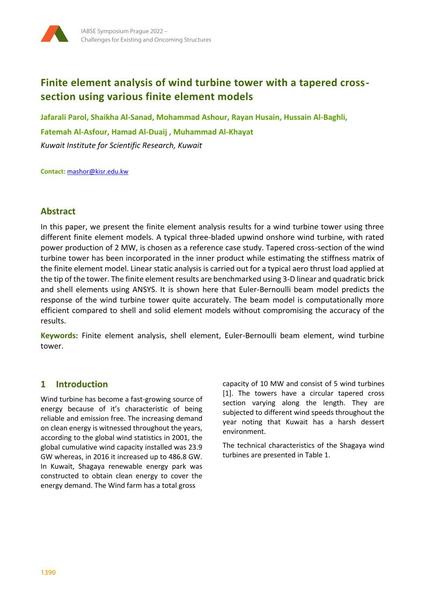Finite element analysis of wind turbine tower with a tapered cross-section using various finite element models

|
|
|||||||||||
Bibliographic Details
| Author(s): |
Jafarali Parol
(Kuwait Institute for Scientific Research, Kuwait)
Shaikha Al-Sanad (Kuwait Institute for Scientific Research, Kuwait) Mohammad Ashour (Kuwait Institute for Scientific Research, Kuwait) Rayan Husain (Kuwait Institute for Scientific Research, Kuwait) Hussain Al-Baghli (Kuwait Institute for Scientific Research, Kuwait) Fatemah Al-Asfour (Kuwait Institute for Scientific Research, Kuwait) Hamad Al-Duaij (Kuwait Institute for Scientific Research, Kuwait) Muhammad Al-Khayat (Kuwait Institute for Scientific Research, Kuwait) |
||||
|---|---|---|---|---|---|
| Medium: | conference paper | ||||
| Language(s): | English | ||||
| Conference: | IABSE Symposium: Challenges for Existing and Oncoming Structures, Prague, Czech Republic, 25-27 May 2022 | ||||
| Published in: | IABSE Symposium Prague 2022 | ||||
|
|||||
| Page(s): | 1390-1395 | ||||
| Total no. of pages: | 6 | ||||
| DOI: | 10.2749/prague.2022.1390 | ||||
| Abstract: |
In this paper, we present the finite element analysis results for a wind turbine tower using three different finite element models. A typical three-bladed upwind onshore wind turbine, with rated power production of 2 MW, is chosen as a reference case study. Tapered cross-section of the wind turbine tower has been incorporated in the inner product while estimating the stiffness matrix of the finite element model. Linear static analysis is carried out for a typical aero thrust load applied at the tip of the tower. The finite element results are benchmarked using 3-D linear and quadratic brick and shell elements using ANSYS. It is shown here that Euler-Bernoulli beam model predicts the response of the wind turbine tower quite accurately. The beam model is computationally more efficient compared to shell and solid element models without compromising the accuracy of the results. |
||||
| Keywords: |
finite element analysis FEA wind turbine tower shell element Euler-Bernoulli beam element
|
||||
| Copyright: | © 2022 International Association for Bridge and Structural Engineering (IABSE) | ||||
| License: | This creative work is copyrighted material and may not be used without explicit approval by the author and/or copyright owner. |
||||
